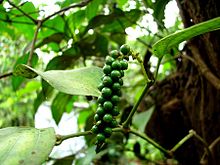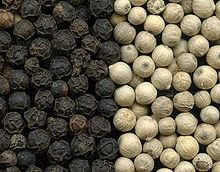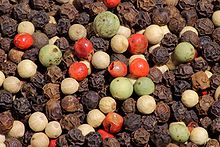 |
|
|
|
|
| Cuisines | Herbal | Spice | Curry | Yeast | Recipe | ||||||
|
Black Pepper Black pepper (Piper nigrum) is a flowering vine in the family Piperaceae, cultivated for its fruit, which is usually dried and used as a spice and seasoning. The fruit, known as a peppercorn when dried, is approximately 5 millimetres (0.20 in) in diameter, dark red when fully mature, and, like all drupes, contains a single seed. Peppercorns, and the powdered pepper derived from grinding them, may be described simply as pepper, or more precisely as black pepper (cooked and dried unripe fruit), green pepper (dried unripe fruit) and white pepper (dried ripe seeds). Black pepper is native to south India, and is extensively cultivated there and elsewhere in tropical regions. Currently Vietnam is the world's largest producer and exporter of pepper, producing 34% of the world's Piper nigrum crop as of 2008. Dried ground pepper has been used since antiquity for both its flavour and as a medicine. Black pepper is the world's most traded spice. It is one of the most common spices added to European cuisine and its descendants. The spiciness of black pepper is due to the chemical piperine. It is ubiquitous in the industrialized world, often paired with table salt. Black pepper Black pepper is produced from the still-green unripe drupes of the pepper plant. The drupes are cooked briefly in hot water, both to clean them and to prepare them for drying. The heat ruptures cell walls in the pepper, speeding the work of browning enzymes during drying. The drupes are dried in the sun or by machine for several days, during which the pepper around the seed shrinks and darkens into a thin, wrinkled black layer. Once dried, the spice is called black peppercorn. On some estates, the berries are separated from the stem by hand and then sun dried without the boiling process. Once the peppercorns are dried, pepper spirit & oil can be extracted from the berries by crushing them. Pepper spirit is used in famous beverages like Coca-Cola and many medicinal and beauty products. Pepper oil is also used as an ayurvedic massage oil and used in certain beauty and herbal treatments. White pepperWhite pepper consists of the seed of the pepper plant alone, with the darker coloured skin of the pepper fruit removed. This is usually accomplished by a process known as retting, where fully ripe red pepper berries are soaked in water for about a week, during which the flesh of the pepper softens and decomposes. Rubbing then removes what remains of the fruit, and the naked seed is dried. Sometimes alternative processes are used for removing the outer pepper from the seed, including removing the outer layer through mechanical, chemical or biological methods. Ground white pepper is sometimes used in Chinese cooking or in dishes like salad, light-coloured sauces or mashed potatoes, where black pepper would visibly stand out. White pepper has a slightly different flavour from black pepper due to the lack of certain compounds which are present in the outer fruit layer of the drupe but are not found in the seed. Green pepper Green pepper, like black, is made from the unripe drupes. Dried green peppercorns are treated in a way that retains the green color, such as treatment with sulfur dioxide, canning or freeze-drying. Pickled peppercorns, also green, are unripe drupes preserved in brine or vinegar. Fresh, unpreserved green pepper drupes, largely unknown in the West, are used in some Asian cuisines, particularly Thai cuisine. Their flavour has been described as piquant and fresh, with a bright aroma. They decay quickly if not dried or preserved. Orange pepper and red pepperOrange pepper or red pepper usually consists of ripe red pepper drupes preserved in brine and vinegar. Ripe red peppercorns can also be dried using the same colour-preserving techniques used to produce green pepper. Pink pepper and other plants used as pepperPink pepper from Piper nigrum is distinct from the more-common dried "pink peppercorns", which are actually the fruits of a plant from a different family, the Peruvian pepper tree, Schinus molle, or its relative the Brazilian pepper tree, Schinus terebinthifolius. As medicineLike many eastern spices, pepper was historically both a seasoning and a medicine. Long pepper, being stronger, was often the preferred medication, but both were used. Black Pepper (or perhaps long pepper) was believed to cure illness such as constipation, diarrhea, earache, gangrene, heart disease, hernia, hoarseness, indigestion, insect bites, insomnia, joint pain, liver problems, lung disease, oral abscesses, sunburn, tooth decay, and toothaches. Various sources from the 5th century onward also recommend pepper to treat eye problems, often by applying salves or poultices made with pepper directly to the eye. There is no current medical evidence that any of these treatments has any benefit; pepper applied directly to the eye would be quite uncomfortable and possibly damaging. Nevertheless, Black pepper, either powdered or its decoction, is widely used in traditional Indian medicine and as a home remedy for relief from sore throat, throat congestion, cough etc. Pepper is known to cause sneezing. Some sources say that piperine, a substance present in black pepper, irritates the nostrils, causing the sneezing; Few, if any, controlled studies have been carried out to answer the question. It has been shown that piperine can dramatically increase absorption of selenium, vitamin B, beta-carotene and curcumin as well as other nutrients. As a medicine, pepper appears in the Buddhist Sama耨aphala Sutta, chapter five, as one of the few medicines allowed to be carried by a monk. Pepper contains small amounts of safrole, a mildly carcinogenic compound. Also, it is eliminated from the diet of patients having abdominal surgery and ulcers because of its irritating effect upon the intestines, being replaced by what is referred to as a bland diet. However, extracts from black pepper have been found to have antioxidant properties and anti-carcinogenic effects, especially when compared to chili. Piperine present in black pepper acts as a thermogenic compound. Piperine enhances the thermogenesis of lipid and accelerates energy metabolism in the body and also increases the serotonin and beta-endorphin production in the brain. Piperine and other components from black pepper may also be helpful in treating vitiligo, although when combined with UV radiation should be staggered due to the effect of light on the compound. FlavourPepper gets its spicy heat mostly from the piperine compound, which is found both in the outer fruit and in the seed. Black pepper contains between 4.6% and 9.7% piperine by mass, and white pepper slightly more than that. Refined piperine, by weight, is about one percent as hot as the capsaicin in chili peppers.[citation needed] The outer fruit layer, left on black pepper, also contains important odour-contributing terpenes including pinene, sabinene, limonene, caryophyllene, and linalool, which give citrusy, woody, and floral notes. These scents are mostly missing in white pepper, which is stripped of the fruit layer. White pepper can gain some different odours (including musty notes) from its longer fermentation stage. Pepper loses flavour and aroma through evaporation, so airtight storage helps preserve pepper's original spiciness longer. Pepper can also lose flavour when exposed to light, which can transform piperine into nearly tasteless isochavicine. Once ground, pepper's aromatics can evaporate quickly; most culinary sources recommend grinding whole peppercorns immediately before use for this reason. Handheld pepper mills or grinders, which mechanically grind or crush whole peppercorns, are used for this, sometimes instead of pepper shakers, dispensers of pre-ground pepper. Spice mills such as pepper mills were found in European kitchens as early as the 14th century, but the mortar and pestle used earlier for crushing pepper have remained a popular method for centuries after as well. |











